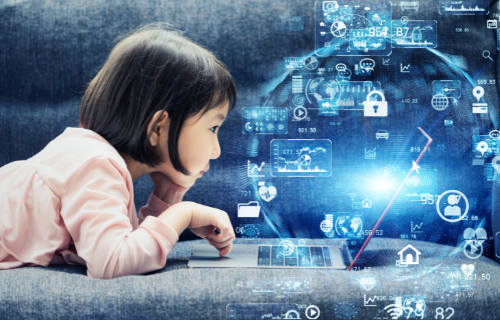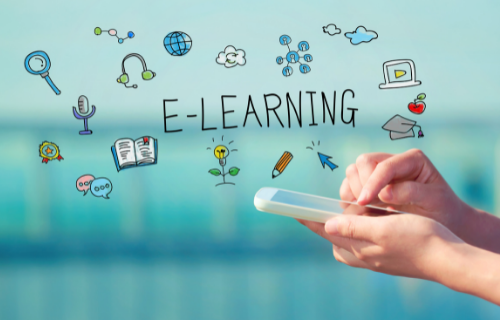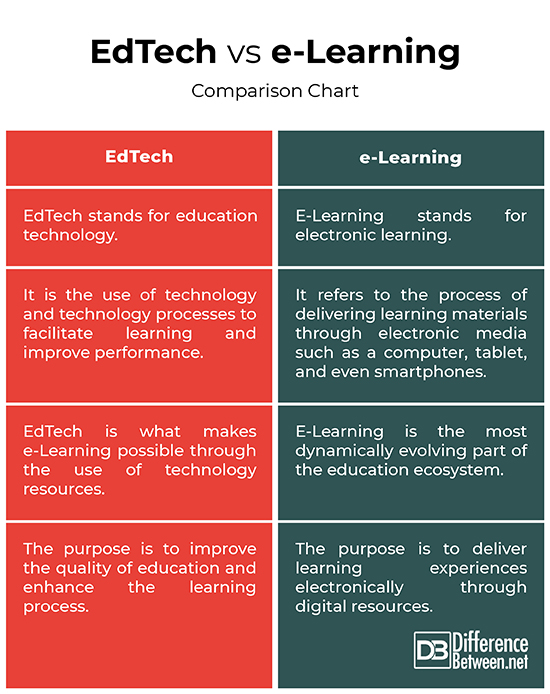Difference Between EdTech and eLearning
As with every other sector, the technology revolution has greatly impacted the education sector as well, bringing the teachers of today into a brave new world of blended and distance learning. Technology has revolutionized how students learn and how teachers teach. Today, there are so many tools out there at teacher’s disposal and it makes them wonder just how to cut through the noise to use technology for learning. Online learning has become one of the fastest growing industries in recent times; particularly the pandemic has a big role to play in this transition. Digital technologies such as EdTech and eLearning are changing the education landscape.

What is EdTech?
EdTech, short for education technology, is the new technological evolution in the classroom that uses digital technology to facilitate learning. It often refers to the group of companies that create educational technology. EdTech refers to a wide range of technologies used in education. In schools, EdTech is the use of technology and technology processes to facilitate learning and improve performance. It can involve a wide range of learning experiences that integrate technology. The learning experiences can be improved in a variety of settings, such as formal and informal learning, learning on demand, workplace learning, and so on.
Helping people to learn is the primary purpose of EdTech. However, the approaches to education technology have evolved from early uses of teaching tools and have recently expanded to include mobile technologies, virtual and augmented realities, social networking, collaborative learning, cloud computing, flipped classrooms, and more. The term technology here refers to the use of both hardware and software. EdTech tools can range from learning apps such as Kahoot! and FlipGrid to VR headsets and data science-based platforms.

What is e-Learning?
E-Learning stands for electronic learning and it allows people to learn via electronic media, typically on the internet. It allows users to take courses online using electronic devices, such as a computer, tablet, and even smartphones. It is a learning experience delivered electronically through digital resources. Traditionally, physical resources such as books and a library were a major component in the structure of a student’s study system. For teachers, e-Learning is an effective way to educate their students and tracking their participation and progress.
It offers a great alternative to paper-based learning and contributes to a more environment friendly workspace. In an organization, e-Learning can impact the entire employee lifecycle, from conducting interviews to finding the right candidates to on-boarding and everything in between.
Much of e-Learning experiences can be summarized into three main areas:
- The social interactions are facilitated by technology systems.
- The interactions between teachers and students are mediated by technology systems.
- The information access system is bound by technology, with both learning and social consequences.
Difference between EdTech and e-Learning
Meaning
– EdTech refers to new technological implementation in the classroom, using digital technology to facilitate learning. It is the use of technology and technology processes to facilitate learning and improve performance. The term technology here refers to the use of both hardware and software. E-Learning stands for electronic learning and refers to the process of delivering learning materials through electronic media such as a computer, tablet, and even smartphones.
Purpose of EdTech and e-Learning
– The purpose of education technology is to improve the quality of education and enhance the learning process, and develop relationships between teachers and students. It provides learning experiences by using technological processes and resources. E-Learning is about helping businesses and other organizations to have more control over how to empower learners to absorb personal accomplishment. For students, it helps them develop technical skills or earn a professional degree, without physically attending a college or university.
Tools
– EdTech has evolved from early uses of teaching tools and have recently expanded to include mobile technologies, virtual and augmented realities, social networking, collaborative learning, cloud computing, flipped classrooms, and more. The EdTech tools can range from learning apps such as Kahoot! and FlipGrid to VR headsets and data science-based platforms. Coming to e-Learning, some of the common tools include Microsoft Office suite, Trello, Google Drive, Google Calendar, Elucidat, YouTube, Google Docs, Zoom, Grammarly, and more.
EdTech vs. e-Learning: Comparison Chart

Summary
Modernization is a constant process, and every industry is going through that process. The education sector is also a part of this modernization process. Aiding in that process are the digital technologies of today, such as EdTech and e-Learning. EdTech is education technology, meaning it refers to use of technology and technology processes to facilitate learning and improve performance. E-Learning is part of EdTech which focuses on delivering learning experiences through the use of electronic devices, such as computer, laptop, tablet, and even smartphones.
What is EdTech education?
EdTech is education technology and combines IT tools and education practices to facilitate learning in classrooms and improve students’ education outcomes.
What is the difference between eLearning and Econtent?
E-content, also known as digital content, refers to the information or content delivered over a computer network such as the Internet. It is a production subfield of e-Learning.
Is Byjus an EdTech company?
Yes, Byjus is an EdTech company; in fact, it’s one of the largest business-to-consumer (B2C) EdTech companies in the K-12 segment.
What is included in EdTech?
EdTech is the practice of integrating IT tools into the classroom to create more personalized learning experiences for students and teachers or educators alike. EdTech tools can range from learning apps such as Kahoot! and FlipGrid to VR headsets and data science-based platforms.
- Difference Between Caucus and Primary - June 18, 2024
- Difference Between PPO and POS - May 30, 2024
- Difference Between RFID and NFC - May 28, 2024
Search DifferenceBetween.net :
Leave a Response
References :
[0]Januszewski, Al and Michael Molenda. Educational Technology: A Definition with Commentary. England, UK: Routledge, 2013. Print
[1]Huang, Ronghuai, et al. Educational Technology: A Primer for the 21st Century. Berlin, Germany: Springer, 2019. Print
[2]Spratt, Christine and Paul Lajbcygier. E-Learning Technologies and Evidence-Based Assessment Approaches. Pennsylvania, United States: IGI Global, 2009. Print
